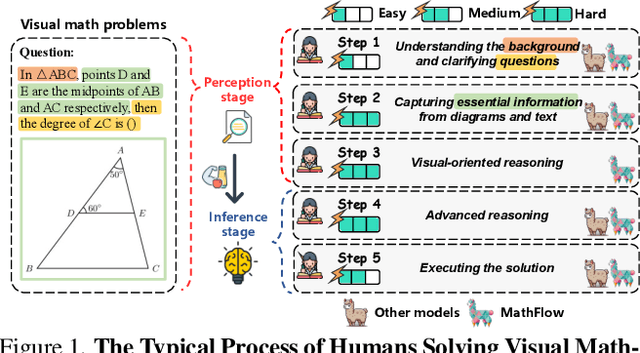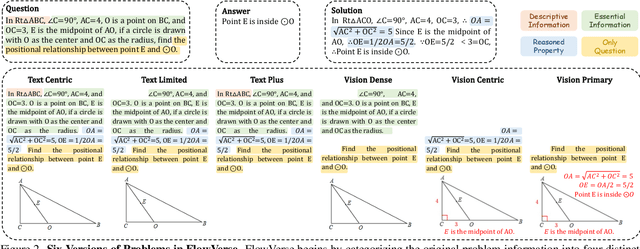Tao Feng
C-Flat++: Towards a More Efficient and Powerful Framework for Continual Learning
Aug 26, 2025Abstract:Balancing sensitivity to new tasks and stability for retaining past knowledge is crucial in continual learning (CL). Recently, sharpness-aware minimization has proven effective in transfer learning and has also been adopted in continual learning (CL) to improve memory retention and learning efficiency. However, relying on zeroth-order sharpness alone may favor sharper minima over flatter ones in certain settings, leading to less robust and potentially suboptimal solutions. In this paper, we propose \textbf{C}ontinual \textbf{Flat}ness (\textbf{C-Flat}), a method that promotes flatter loss landscapes tailored for CL. C-Flat offers plug-and-play compatibility, enabling easy integration with minimal modifications to the code pipeline. Besides, we present a general framework that integrates C-Flat into all major CL paradigms and conduct comprehensive comparisons with loss-minima optimizers and flat-minima-based CL methods. Our results show that C-Flat consistently improves performance across a wide range of settings. In addition, we introduce C-Flat++, an efficient yet effective framework that leverages selective flatness-driven promotion, significantly reducing the update cost required by C-Flat. Extensive experiments across multiple CL methods, datasets, and scenarios demonstrate the effectiveness and efficiency of our proposed approaches. Code is available at https://github.com/WanNaa/C-Flat.
Physics-Grounded Motion Forecasting via Equation Discovery for Trajectory-Guided Image-to-Video Generation
Jul 09, 2025Abstract:Recent advances in diffusion-based and autoregressive video generation models have achieved remarkable visual realism. However, these models typically lack accurate physical alignment, failing to replicate real-world dynamics in object motion. This limitation arises primarily from their reliance on learned statistical correlations rather than capturing mechanisms adhering to physical laws. To address this issue, we introduce a novel framework that integrates symbolic regression (SR) and trajectory-guided image-to-video (I2V) models for physics-grounded video forecasting. Our approach extracts motion trajectories from input videos, uses a retrieval-based pre-training mechanism to enhance symbolic regression, and discovers equations of motion to forecast physically accurate future trajectories. These trajectories then guide video generation without requiring fine-tuning of existing models. Evaluated on scenarios in Classical Mechanics, including spring-mass, pendulums, and projectile motions, our method successfully recovers ground-truth analytical equations and improves the physical alignment of generated videos over baseline methods.
Branch, or Layer? Zeroth-Order Optimization for Continual Learning of Vision-Language Models
Jun 14, 2025Abstract:Continual learning in vision-language models (VLMs) faces critical challenges in balancing parameter efficiency, memory consumption, and optimization stability. While First-Order (FO) optimization (e.g., SGD) dominate current approaches, their deterministic gradients often trap models in suboptimal local minima and incur substantial memory overhead. This paper pioneers a systematic exploration of Zeroth-Order (ZO) optimization for vision-language continual learning (VLCL). We first identify the incompatibility of naive full-ZO adoption in VLCL due to modality-specific instability. To resolve this, we selectively applying ZO to either vision or language modalities while retaining FO in the complementary branch. Furthermore, we develop a layer-wise optimization paradigm that interleaves ZO and FO across network layers, capitalizing on the heterogeneous learning dynamics of shallow versus deep representations. A key theoretical insight reveals that ZO perturbations in vision branches exhibit higher variance than language counterparts, prompting a gradient sign normalization mechanism with modality-specific perturbation constraints. Extensive experiments on four benchmarks demonstrate that our method achieves state-of-the-art performance, reducing memory consumption by 89.1% compared to baselines. Code will be available upon publication.
Router-R1: Teaching LLMs Multi-Round Routing and Aggregation via Reinforcement Learning
Jun 10, 2025Abstract:The rapid emergence of diverse large language models (LLMs) has spurred the development of LLM routers that assign user queries to the most suitable model. However, existing LLM routers typically perform a single-round, one-to-one mapping (\textit{i.e.}, assigning each query to a single model in isolation), which limits their capability to tackle complex tasks that demand the complementary strengths of multiple LLMs. In this paper, we present \textbf{Router-R1}, a reinforcement learning (RL)-based framework that formulates multi-LLM routing and aggregation as a sequential decision process. Router-R1 instantiates the router itself as a capable LLM, leveraging its reasoning ability to interleave "think" actions (internal deliberation) with "route" actions (dynamic model invocation), and integrates each response into its evolving context. To guide learning, we employ a lightweight rule-based reward comprising format rewards, final outcome rewards, and a novel cost reward for performance and cost trade-off optimization, opening a pathway toward optimizing performance-cost tradeoffs via RL. Router-R1 also conditions only on simple model descriptors such as pricing, latency, and example performance, enabling strong generalization to unseen model selection. Experiments on seven general and multi-hop QA benchmarks show that Router-R1 outperforms over several strong baselines, achieving superior performance while maintaining robust generalization and cost management.Code is available at https://github.com/ulab-uiuc/Router-R1.
Adapt before Continual Learning
Jun 05, 2025Abstract:Continual Learning (CL) seeks to enable neural networks to incrementally acquire new knowledge (plasticity) while retaining existing knowledge (stability). While pre-trained models (PTMs) have become pivotal in CL, prevailing approaches freeze the PTM backbone to preserve stability, limiting their plasticity, particularly when encountering significant domain gaps in incremental tasks. Conversely, sequentially finetuning the entire PTM risks catastrophic forgetting of generalizable knowledge, exposing a critical stability-plasticity trade-off. To address this challenge, we propose Adapting PTMs before the core CL process (ACL), a novel framework that refines the PTM backbone through a plug-and-play adaptation phase before learning each new task with existing CL approaches (e.g., prompt tuning). ACL enhances plasticity by aligning embeddings with their original class prototypes while distancing them from others, theoretically and empirically shown to balance stability and plasticity. Extensive experiments demonstrate that ACL significantly improves CL performance across benchmarks and integrated methods, offering a versatile solution for PTM-based CL. Code is available at https://github.com/byyx666/ACL_code.
Rethinking the Stability-Plasticity Trade-off in Continual Learning from an Architectural Perspective
Jun 05, 2025Abstract:The quest for Continual Learning (CL) seeks to empower neural networks with the ability to learn and adapt incrementally. Central to this pursuit is addressing the stability-plasticity dilemma, which involves striking a balance between two conflicting objectives: preserving previously learned knowledge and acquiring new knowledge. While numerous CL methods aim to achieve this trade-off, they often overlook the impact of network architecture on stability and plasticity, restricting the trade-off to the parameter level. In this paper, we delve into the conflict between stability and plasticity at the architectural level. We reveal that under an equal parameter constraint, deeper networks exhibit better plasticity, while wider networks are characterized by superior stability. To address this architectural-level dilemma, we introduce a novel framework denoted Dual-Arch, which serves as a plug-in component for CL. This framework leverages the complementary strengths of two distinct and independent networks: one dedicated to plasticity and the other to stability. Each network is designed with a specialized and lightweight architecture, tailored to its respective objective. Extensive experiments demonstrate that Dual-Arch enhances the performance of existing CL methods while being up to 87% more compact in terms of parameters. Code: https://github.com/byyx666/Dual-Arch.
Object Isolated Attention for Consistent Story Visualization
Mar 30, 2025Abstract:Open-ended story visualization is a challenging task that involves generating coherent image sequences from a given storyline. One of the main difficulties is maintaining character consistency while creating natural and contextually fitting scenes--an area where many existing methods struggle. In this paper, we propose an enhanced Transformer module that uses separate self attention and cross attention mechanisms, leveraging prior knowledge from pre-trained diffusion models to ensure logical scene creation. The isolated self attention mechanism improves character consistency by refining attention maps to reduce focus on irrelevant areas and highlight key features of the same character. Meanwhile, the isolated cross attention mechanism independently processes each character's features, avoiding feature fusion and further strengthening consistency. Notably, our method is training-free, allowing the continuous generation of new characters and storylines without re-tuning. Both qualitative and quantitative evaluations show that our approach outperforms current methods, demonstrating its effectiveness.
UniSync: A Unified Framework for Audio-Visual Synchronization
Mar 20, 2025Abstract:Precise audio-visual synchronization in speech videos is crucial for content quality and viewer comprehension. Existing methods have made significant strides in addressing this challenge through rule-based approaches and end-to-end learning techniques. However, these methods often rely on limited audio-visual representations and suboptimal learning strategies, potentially constraining their effectiveness in more complex scenarios. To address these limitations, we present UniSync, a novel approach for evaluating audio-visual synchronization using embedding similarities. UniSync offers broad compatibility with various audio representations (e.g., Mel spectrograms, HuBERT) and visual representations (e.g., RGB images, face parsing maps, facial landmarks, 3DMM), effectively handling their significant dimensional differences. We enhance the contrastive learning framework with a margin-based loss component and cross-speaker unsynchronized pairs, improving discriminative capabilities. UniSync outperforms existing methods on standard datasets and demonstrates versatility across diverse audio-visual representations. Its integration into talking face generation frameworks enhances synchronization quality in both natural and AI-generated content.
MathFlow: Enhancing the Perceptual Flow of MLLMs for Visual Mathematical Problems
Mar 19, 2025



Abstract:Despite impressive performance across diverse tasks, Multimodal Large Language Models (MLLMs) have yet to fully demonstrate their potential in visual mathematical problem-solving, particularly in accurately perceiving and interpreting diagrams. Inspired by typical processes of humans, we hypothesize that the perception capabilities to extract meaningful information from diagrams is crucial, as it directly impacts subsequent inference processes. To validate this hypothesis, we developed FlowVerse, a comprehensive benchmark that categorizes all information used during problem-solving into four components, which are then combined into six problem versions for evaluation. Our preliminary results on FlowVerse reveal that existing MLLMs exhibit substantial limitations when extracting essential information and reasoned property from diagrams and performing complex reasoning based on these visual inputs. In response, we introduce MathFlow, a modular problem-solving pipeline that decouples perception and inference into distinct stages, thereby optimizing each independently. Given the perceptual limitations observed in current MLLMs, we trained MathFlow-P-7B as a dedicated perception model. Experimental results indicate that MathFlow-P-7B yields substantial performance gains when integrated with various closed-source and open-source inference models. This demonstrates the effectiveness of the MathFlow pipeline and its compatibility to diverse inference frameworks. The FlowVerse benchmark and code are available at https://github.com/MathFlow-zju/MathFlow.
GraphEval: A Lightweight Graph-Based LLM Framework for Idea Evaluation
Mar 16, 2025Abstract:The powerful capabilities of Large Language Models (LLMs) have led to their growing use in evaluating human-generated content, particularly in evaluating research ideas within academic settings. Existing solutions primarily rely on prompt-based LLM methods or fine-tuned lightweight language models for idea evaluation. However, these methods are often unstable and struggle to comprehend the complex semantic information embedded in the ideas, impeding their ability to perform high-quality evaluations. To address the above challenges, we propose GraphEval, a lightweight graph-based LLM framework for idea evaluation. Our insight is that a complex idea can be broken down into comprehensible viewpoint nodes using prompts from small LLMs. These viewpoint nodes can then be linked together through edges created from LLM-based relation extraction and/or BERT similarity scores. The created viewpoint-graph can be used to conveniently propagate scores across view-nodes to improve the robustness of the idea evaluations. In particular, we propose two lightweight graph-based methods for idea evaluation: (1) GraphEval-LP: a training-free label propagation algorithm that propagates evaluation scores from known view-nodes to unknown nodes; (2) GraphEval-GNN: a Graph Neural Networks (GNN) that is trained to predict the evaluation scores given the observed graph with minimal computation resources. Moreover, to overcome LLM's limitation in objectively assessing the novelty of ideas, we further propose a novelty detection model to GraphEval-GNN to enhance its capability in judging idea novelty. Experiments on two datasets show GraphEval improves F1 scores by at least 14% with low computation and API costs. Additionally, GraphEval can effectively detect plagiarized ideas.
 Add to Chrome
Add to Chrome Add to Firefox
Add to Firefox Add to Edge
Add to Edge